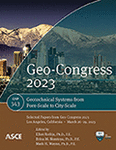Numerical Study on the Ground Behavior with Basal Heave during Vertical Shaft Excavation in Clays
Publication: Geo-Congress 2023
ABSTRACT
When excavating a vertical shaft in clay, basal heave may occur as depth increases. Basal heave can be hazardous to workers by destabilizing the excavation surface and causing ground deformation that deteriorates the stability of the surrounding ground. Therefore, before constructing a vertical shaft in clay, the behavior of the surrounding ground owing to basal heave should be investigated. Herein, the behavior of the ground surrounding a vertical shaft owing to basal heave was numerically simulated by assuming specific excavation conditions of a vertical shaft for different excavation depths in soft clay. The thickness of the shaft embedment was a variable used to improve the stability of the vertical shaft base; the effects of this parameter on the deformation of the basal heave and surrounding ground were analyzed. The result revealed that the installation of the shaft embedment reduced basal heave displacement, thereby suppressing the deformation of the surrounding ground.
Get full access to this article
View all available purchase options and get full access to this chapter.
REFERENCES
Bjerrum, L., and Eide, O. (1956). “Stability of strutted excavations in clay.” Geotechnique, 6(1), 32–47.
Goh, A., Kulhawy, F., and Wong, K. (2008). “Reliability assessment of basal-heave stability for braced excavations in clay.” J. Geotech. Geoenviron. Eng., 134(2), 145–153.
Goh, A. T. (2017). “Basal heave stability of supported circular excavations in clay.” Tunn. Undergr. Space Technol., 61, 145–149.
Hsieh, P.-G., Ou, C.-Y., and Liu, H.-T. (2008). “Basal heave analysis of excavations with consideration of anisotropic undrained strength of clay.” Can. Geotech. J., 45(6), 788–799.
Itasca Consulting Group, Inc. (2012). Fast lagrangian analysis of continua in 3 dimensions User’s Guide: Version 5.0. Minneapolis, USA.
Japan Society of Architecture. (1988). Guidelines of design and construction of deep excavation. Japan Society of Architecture, Tokyo.
Kang, S. J., Cho, G. C., Kim, J. T., Cha, Y., and Hong, E. S. (2018). “An experimental study for the effect of soil plug on the basal heave stability for the vertical shaft excavation in clay”, J. of Korean Tunn. Undergr. Sp. Assoc., 20(1), 183–195.
Khatri, V. N., and Kumar, J. (2010). “Stability of an unsupported vertical circular excavation in clays under undrained condition.” Comput. Geotechn., 37(3), 419–424.
Li, X., Xu, H., Li, C., Sun, L., and Wang, R. (2016). “Study on the demand and driving factors of urban underground space use.” Tunn. Undergr. Space Technol., 55, 52–58.
Parashar, S., Mitchell, R., Hee, M. W., Sanmugnathan, D., and Nicholson, G. (2007). “Performance monitoring of deep shafts at Changi WRP project, Singapore.” 7th FMGM 2007: Field Measurements in Geomechanics, 1–12.
Roscoe, K., and Burland, J. B. (1968). “On the generalized stress-strain behaviour of wet clay.” in: J. Heyman, F. Leckie (Eds.), Engineering plasticity, Cambridge University Press, Cambridge, 535–609.
Su, S. F., Liao, H. J., and Lin, Y. H. (1998). “Base Stability of Deep Excavation in Anisotropic Soft Clay.” J. Geotech. Geoenviron. Eng., 124(9), 809–819.
Terzaghi, K. (1943). Theoretical soil mechanics, John Wiley & Sons, New York.
Ti, K. S., Huat, B. B., Noorzaei, J., Jaafar, M. S., and Sew, G. S. (2009). “A review of basic soil constitutive models for geotechnical application.” Electron. J. Geotech. Eng., 14, 1–18.
Tobar, T., and Meguid, M. A. (2010). “Comparative evaluation of methods to determine the earth pressure distribution on cylindrical shafts: A review.” Tunn. Undergr. Space Technol., 25(2), 188–197.
Ukritchon, B., Whittle, A. J., and Sloan, S. W. (2003). “Undrained Stability of Braced Excavations in Clay.” J. Geotech. Geoenviron. Eng., 129(8), 738–755.
Watabe, Y., Tsuchida, T., and Adachi, K. (2002). “Undrained Shear Strength of Pleistocene Clay in Osaka Bay.” J. Geotech. Geoenviron. Eng., 128(3), 216–226.
Information & Authors
Information
Published In
History
Published online: Mar 23, 2023
Authors
Metrics & Citations
Metrics
Citations
Download citation
If you have the appropriate software installed, you can download article citation data to the citation manager of your choice. Simply select your manager software from the list below and click Download.
